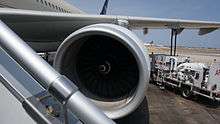Rolls-Royce Trent 700
| Trent 700 | |
|---|---|
 | |
| Rolls-Royce Trent 700 mounted on an EgyptAir A330-200 | |
| Type | Turbofan |
| Manufacturer | Rolls-Royce |
| First run | 1990 |
| Major applications | Airbus A330 |
| Unit cost | 23.25 million US$ list price[1] |
| Developed into | Rolls-Royce Trent XWB |

The Rolls-Royce Trent 700 is a three spool high bypass turbofan aircraft engine, developed from the RB211, and is the first variant of the family of Trent engines.
Design and development
When Airbus was planning its new twin-jet A330 in the late 1980s, Rolls-Royce proposed a version of the Trent 600 (known as the Trent 680) to power it. However, as the A330's design weight increased, it became clear that more thrust would be required, and Rolls proposed the Trent 720, the first member of the Trent 700 series.
In April 1989 Cathay Pacific became the first customer to specify an Airbus aircraft powered by Rolls-Royce engines when it ordered ten A330s powered by the Trent 700. The following month TWA followed suit with an order for twenty A330s. Air Canada chose the engine for its fleet of eight A330-300s.
The Trent 700 first ran in August 1990, and certification was achieved in January 1994. 90 minutes ETOPS approval was achieved in March 1995, and this was extended to 120 minutes in December 1995 and 180 minutes in May 1996.
In 2009 Rolls-Royce introduced an upgraded version of the engine dubbed the Trent 700EP (enhanced performance) which incorporated a package of improvements derived from later members of the Trent engine family (especially the Trent 1000). These included elliptical leading edges and optimised fan and high pressure turbine tip clearances.[2] Together the improvements provided a 1.2% improvement to the Trent 700's specific fuel consumption. Some of the improvements were also made available as a retro-fit kit to existing airlines.[3]
Further upgrades were announced in 2013 as part of the T700EP2 package. The upgraded engine will be available in 2015 and is intended for higher gross weight A330s. This upgrade package will improve fuel efficiency by about 1% and is likely to be the last upgrade of Trent 700. It may also be available as a retrofit package in the future.[4]
Rolls-Royce claims that the Trent 700 has the lowest life cycle fuel burn, and is the quietest and cleanest engine available on the A330. Cathay Pacific is the largest operator, with 31 Trent 700-powered A330s. Rolls received orders for 140 of the type during the Paris Air Show in June 2007. The Trent 700 was the third engine to market on the A330, after GE and PW.
Rolls-Royce claims a 58% market share.[5]
Applications
The Trent 700 family powers the Airbus A330. It comes in 2 thrust ratings, 67,500 lbf (300 kN) and 71,100 lbf (316 kN).[6] It first entered service on Cathay Pacific's A330s in March 1995.
Variants
- Trent 768-60
- Certified in January 1994, rated at 67,500 lbf (300 kN) for take-off.[6] Used on the Airbus A330-341 variant.
- Trent 772-60
- Certified in March 1994, rated at 71,100 lbf (316 kN) for take-off.[6] Used on the Airbus A330-342 variant.
- Trent 772B-60
- Certified in September 1997, rated at 71,100 lbf (316 kN) for take-off, produces additional thrust compared to the 772-60 between 610m (2,000ft) and 2440m (8,000ft).[6] Used on the Airbus A330-243 and Airbus A330-343 variants.
- Trent 772C-60
- Certified in March 2006, rated at 71,100 lbf (316 kN) for take-off, produces additional thrust compared to the 772B-60 above 2440m (8,000ft).[6] Used on the Airbus A330-243 and Airbus A330-343 variants.
Specifications (Trent 700)
Data from EASA[6]
General characteristics
- Type: three shaft high bypass ratio, axial flow, turbofan
- Length: 5.639 m (222.0 in)
- Diameter: 2.47 m (97.4 in)[7] (fan)
- Dry weight: 6,160 kg (13,580 lb)
Components
- Compressor: 26-off Wide Chord Fan Blades, eight-stage IP compressor, six-stage HP compressor
- Combustors: single annular combustor, 24-off Fuel Spray Nozzles
- Turbine: Single-stage HP turbine, single-stage IP turbine, four-stage LP turbine
Performance
- Maximum thrust: 300.3–316.3 kN (67,500–71,100 lbf)
- Overall pressure ratio: 36:1[7]
- Bypass ratio: 5.0:1[7]
- Specific fuel consumption: 0.565 lb/lbf/h (16.0 g/kN/s) [8] (cruise)
- Thrust-to-weight ratio: 51.35 N/kg (5.236 lbf/lb)
See also
- Comparable engines
- Related lists
References
Notes
- ↑ "Rolls-Royce Trent 700 engines worth $930m selected by International AirFinance Corporation". Rolls-Royce. 20 July 2015.
- ↑ "DUBAI: R-R hands over 1,000th Trent 700 for A330". Flightglobal. November 13, 2011. Retrieved 2012-01-26.
- ↑ "EP new build improvements". Aviation Week. March 28, 2009. Retrieved 2012-01-26.
- ↑ Goold, Ian (18 June 2013). "Rolls-Royce Trent 700 Benefits From Technology Development Flow-Back". AINonline. Retrieved 4 April 2014.
- ↑ "Trent 700 Market". Rolls-Royce.
- 1 2 3 4 5 6 "Type-Certificate Data Sheet RB211 Trent 700 series engines" (PDF). EASA. 14 October 2014.
- 1 2 3 "Trent 700 poster". Rolls-Royce.
- ↑ Dr Jim Scanlan, ed. (16 July 1999). "Rolls-Royce Turbofan Engines cost and performance data Spreadsheet". Southampton University.
External links
| Wikimedia Commons has media related to Rolls-Royce Trent 700. |